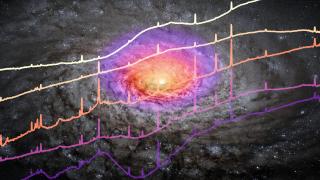Bibcode
Riffel, Rogério; Mallmann, Nicolas D.; Rembold, Sandro B.; Ilha, Gabriele S.; Riffel, Rogemar A.; Storchi-Bergmann, Thaisa; Ruschel-Dutra, Daniel; Vazdekis, Alexandre; Martín-Navarro, Ignacio; Schimoia, Jaderson S.; Ramos Almeida, Cristina; da Costa, Luiz N.; Vila-Verde, Glauber C.; Gatto, Lara
Referencia bibliográfica
Monthly Notices of the Royal Astronomical Society
Fecha de publicación:
10
2023
Número de citas
29
Número de citas referidas
26
Descripción
We present spaxel-by-spaxel stellar population fits for the ~10 000 MaNGA data cubes. We provide multiple extension fits files, nominated as MEGACUBES, with maps of several properties as well as emission-line profiles that are provided for each spaxel. All the MEGACUBES are available through a web interface (https://manga.linea.org.br/ or http://www.if.ufrgs.br/~riffel/software/megacubes/). We also defined a final Active Galactic Nuclei (AGN) sample, as well as a control sample matching the AGN host galaxy properties. We have analysed the stellar populations and spatially resolved emission-line diagnostic diagrams of these AGNs and compared them with the control galaxies sample. We find that the relative fractions of young (t ≤56 Myr) and intermediate-age (100 Myr ≤t ≤ 2 Gyr) show predominantly a positive gradient for both AGNs and controls. The relative fraction of intermediate-age stellar population is higher in AGN hosts when compared to the control sample, and this difference becomes larger for higher [O III] luminosity AGNs. We attribute this to the fact that extra gas is available in these more luminous sources and that it most likely originates from mass-loss from the intermediate-age stars. The spatially resolved diagnostic diagrams reveal that the AGN emission is concentrated in the inner 0.5 Re (effective radius) region of the galaxies, showing that the AGN classification is aperture dependent and that emission-line ratios have to be taken together with the H α equivalent width for proper activity classification. We present a composite 'BPT+WHAN' diagram that produces a more comprehensive mapping of the gas excitation.
Proyectos relacionados

Actividad Nuclear en Galaxias: una Perspectiva 3D del Núcleo y su Entorno
Nuestro proyecto puede dividirse en dos líneas principales de investigación. En primer lugar, el estudio de los vientos producidos por cuásares luminosos oscurecidos y del impacto que estos tienen en sus galaxias anfitrionas (retroalimentación del AGN). Para ello hemos obtenido observaciones en el óptico e infrarrojo cercano con el Gran Telescopio
Cristina
Ramos Almeida

Huellas de la Formación de las Galaxias: Poblaciones estelares, Dinámica y Morfología
Bienvenida a la página web del g rupo de investigación Traces of Galaxy Formation. Somos un grupo de investigación amplio, diverso y muy activo cuyo objetivo principal es entender la formación de galaxias en el Universo de una manera lo más completa posible. Con el estudio detellado de las poblaciones estelares como bandera, estamos constantemente
Anna
Ferré Mateu